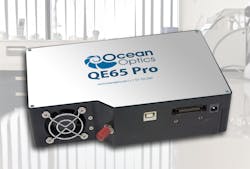Raman and DNA sequencing spectrometer by Ocean Optics
Ocean Optics’ (Dunedin, FL) latest scientific-grade modular spectrometer, the QE65 Pro, features sensitivity and low stray light capabilities to deliver optimal performance in fluorescence, Raman and DNA sequencing spectroscopy. The spectrometer’s optical bench components efficiently manipulate light for greater throughput and higher sensitivity. A thermally robust design promotes spectrometer wavelength stability over a wide temperature range. Its ultralow jitter triggering synchronizes timing accurately with other devices. An extensive range of new gratings have been selected for the spectrometer to optimize wavelength range and stray light performance characteristics. To further tailor the instrument to application needs, replaceable slits can be reconfigured by the user. The spectrometer is capable of low light level detection and long integration times with virtually no spectral distortion.
-----
PRESS RELEASE
Ocean Optics QE65 Pro Scientific Grade Spectrometer
High sensitivity ideal for fluorescence, Raman, DNA and low light levels
Dunedin, FL (June 6, 2012) – Ocean Optics’ (www.OceanOptics.com) latest scientific-grade modular spectrometer, the QE65 Pro, brings enhanced sensitivity and low stray light capabilities to deliver optimal performance in fluorescence, Raman and DNA sequencing spectroscopy.
The QE65 Pro’s new optical bench components more efficiently manipulate light for greater throughput and higher sensitivity. A thermally robust design promotes spectrometer wavelength stability over a wide temperature range. Its ultralow jitter triggering synchronizes timing accurately with other devices.
An extensive range of new gratings have been selected for the QE65 Pro to optimize wavelength range and stray light performance characteristics. To further tailor the instrument to application needs, replaceable slits can be reconfigured by the user in the field. By simply changing the slit, users can more precisely balance optical resolution and throughput needs to achieve highly accurate results with a single multipurpose instrument.
The Hamamatsu FFT-CCD back thinned detector that forms the core of the instrument is distinguished by high quantum efficiency (90% maximum) and low etalon characteristics. Its design significantly improves signal-to-noise ratio (>1000:1) and signal processing speed. The QE65 Pro is capable of low light level detection and long integration times–from 8 milliseconds to 15 minutes, with virtually no spectral distortion.
To learn more about using the QE65 Pro, visit www.qe65pro.com, or call +1 727-733-2447.
About Ocean Optics:
Headquartered in Dunedin, Fla., Ocean Optics is a leading supplier of solutions for optical sensing – fundamental methods of measuring and interpreting the interaction of light with matter. With locations in Asia and Europe, the company has sold more than 200,000 spectrometers worldwide since 1992. Ocean Optics’ extensive line of complementary technologies includes chemical sensors, analytical instrumentation, OEM components and sub-systems, optical fibers, metrology products and optics. The company is a subsidiary of Halma p.l.c., an international market leader in safety, health and sensor technology.
-----
